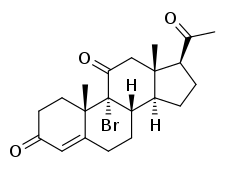Bromoketoprogesterone
Bromoketoprogesterone (BKP), also known as 9α-bromo-11-oxoprogesterone (BOP), and known by the tentative brand name Braxarone (Squibb), is an orally active progestin which does not appear to have been marketed.[1][2][3][4][5]
 | |
| Clinical data | |
|---|---|
| Trade names | Braxarone |
| Other names | BKP; BOP; NSC-15990; 9α-Bromo-11-oxoprogesterone; Braxarone; Bromo-oxy-progesterone; BOP; 9α-Bromopregn-4-en-3,11,20-trione; Bromopregnenetrione |
| Routes of administration | By mouth |
| Identifiers | |
| |
| CAS Number | |
| PubChem CID | |
| ChemSpider | |
| UNII | |
| ChEBI | |
| Chemical and physical data | |
| Formula | C21H27BrO3 |
| Molar mass | 407.348 g·mol−1 |
| 3D model (JSmol) | |
| |
| |
Pharmacology
Pharmacodynamics
Whereas 11-ketoprogesterone and 11β-hydroxyprogesterone are virtually devoid of progestogenic activity (although 11β-hydroxyprogesterone has been reported to possess about 1% of the progestogenic activity of progesterone), the progestogenic activity of BKP is restored and is in fact relatively high.[6][7] In contrast, 9α-fluoro-11β-hydroxyprogesterone has much lower progestogenic activity with only about 8 times that of 11β-hydroxyprogesterone.[7] In addition, whereas 9α-fluoro-11β-hydroxyprogesterone has pronounced mineralocorticoid effects, BKP lacks such effects.[3]
BKP has been described as a weaker progestogen.[8] It has been used at doses of as much as 300 mg orally per day.[9][8]
In addition to its activity as a progestogen, BKP has glucocorticoid activity.[9]
Pharmacokinetics
The pharmacokinetics of BKP have been reviewed.[10]
Chemistry
Synthesis
Chemical syntheses of BKP have been published.[10]
History
It was developed in the 1950s and, along with the testosterone derivatives ethisterone, norethisterone, normethandrone, and norethandrolone and the progesterone derivative hydroxyprogesterone acetate, was one of the first orally active progestogens to be developed.[3] Similarly to various other progestogens, BKP has been studied in the treatment of breast cancer in women.[11][12][9]:185 Evaluated in 1959, it was the first oral progestin to be found effective in the treatment of breast cancer.[12][13][14][9] It induced regression in 20% of women with advanced breast cancer at a dosage of 300 mg/day orally.[9]
References
- Martin Negwer; Hans-Georg Scharnow (2001). Organic-chemical drugs and their synonyms: (an international survey). Wiley-VCH. p. 2134. ISBN 978-3-527-30247-5.
- Tyler ET, Olson HJ (1958). "Clinical use of new progestational steroids in fertility". Ann. N. Y. Acad. Sci. 71 (5): 704–9. doi:10.1111/j.1749-6632.1958.tb46799.x. PMID 13583825.
- Wied GL, Davis ME (1957). "9α-Bromo-11-ketoprogesterone; another new orally effective substance with progestational activity". Obstet Gynecol. 10 (4): 411–7. ISSN 0029-7844. PMID 13477602.
- Tyler, Edward T. (1959). "Fertility promoting and inhibiting effects of new steroid hormonal substances". Journal of the American Medical Association. 169 (16): 1843–54. doi:10.1001/jama.1959.03000330015003. ISSN 0002-9955. PMID 13640942.
- Norman Applezweig (1962). Steroid Drugs. Blakiston Division, McGraw-Hill. p. 444.
- Veterinary Medicine. American Veterinary Publishing Company. 1953.
Ketogestin [(11-ketoprogesterone)] is devoid of androgenic, estrogenic, or progestational activity and is nontoxic in amounts greatly exceeding pharmacological dosage.
- Otto Hoffmann-Ostenhof (1959). Proceedings of the Fourth International Congress of Biochemistry, Vienna, 1-6 September, 1958. and. p. 269.
In addition, it had been previously reported that 11β-hydroxyprogesterone was devoid of progestational action. However, we found that it does possess about 1% of the activity of progesterone. This trace activity is substantially enhanced by fluorination, since 9α-fluoro-11β-hydroxyprogesterone is eight times as active as the non-halogenated analogue.6 Concomitantly, Fried et al.7 described the relatively high progestational activity of 9α-bromo-11-ketoprogesterone as well.
- Henryk Nowakowski; Deutsche Gesellschaft für Endokrinologie (2 July 2013). Moderne Entwicklungen auf dem Gestagengebiet: Hormone in der Veterinärmedizin. Springer-Verlag. pp. 65–. ISBN 978-3-662-25301-4.
- Dao, Thomas L. (1975). "Pharmacology and Clinical Utility of Hormones in Hormone Related Neoplasms". In Alan C. Sartorelli; David G. Johns (eds.). Antineoplastic and Immunosuppressive Agents. pp. 170–192. doi:10.1007/978-3-642-65806-8_11. ISBN 978-3-642-65806-8.
Halogenated progestogens have also been studied in patients with breast cancer. 9α-Bromo-11-oxoprogesterone (bromoketoprogesterone) given in a dose of 300 mg orally daily in patients with advanced breast cancer induced a 20 % regression rate. Regression of cancer occurs mainly in soft tissue and osseous metastases. [...] Both of these progestational compounds possess corticoid activity, particularly oxylone acetate, which, in 50 mg doses, causes Cushingoid symptoms, hypertension, and osteoporosis. On withdrawal of the drug, vaginal bleeding occurs frequently. [...] Progesterone-like compounds with glucocorticoid activity, such as oxylone, induce severe Cushingoid symptoms such as plethora, moonface, glycosuria, marked weight gain, and hypertension, requiring discontinuation of the drug.
- Die Gestagene. Springer-Verlag. 27 November 2013. pp. 9–, 276. ISBN 978-3-642-99941-3.
- Alan C. Sartorelli; David G. Johns (27 November 2013). Antineoplastic and Immunosuppressive Agents. Springer Science & Business Media. pp. 185–. ISBN 978-3-642-65806-8.
- Goldenberg IS, Hayes MA (1959). "Hormonal therapy of metastatic female breast carcinoma. I. 9 alpha-Bromo-11-ketoprogesterone". Cancer. 12 (4): 738–40. doi:10.1002/1097-0142(195907/08)12:4<738::aid-cncr2820120418>3.0.co;2-m. PMID 13663018.
- Carpenter JT (1988). "Progestational agents in the treatment of breast cancer". Cancer Treat. Res. Cancer Treatment and Research. 39: 147–56. doi:10.1007/978-1-4613-1731-9_10. ISBN 978-1-4612-8974-6. PMID 2908605.
- Kaufman RJ (May 1981). "Advanced breast cancer - additive hormonal therapy". Cancer. 47 (10): 2398–403. doi:10.1002/1097-0142(19810515)47:10<2398::aid-cncr2820471013>3.0.co;2-o. PMID 7272894.